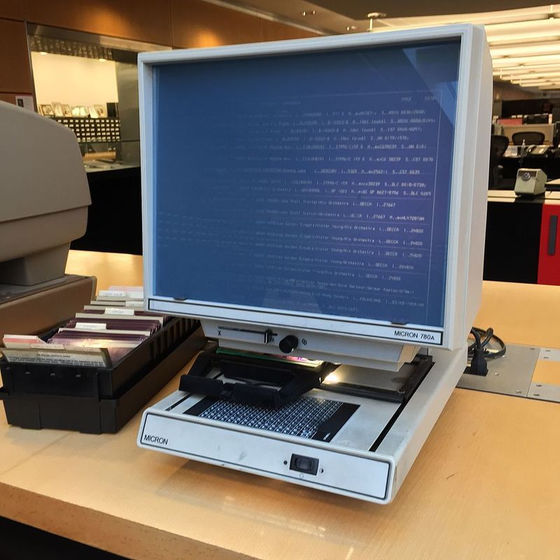Mysterious history of microfilm, from cartoon pigeon to manga book

ByThacher Gallery at the University of San Francisco
In a limited space such as a library, what is being used to store an enormous amount of materials is "MicrofilmIt is a photographic film called. Microfilm shrinks documents and photographs and burns them to film and uses it for enlarging with a dedicated machine when browsing, but the history from microfilm's birth to popularization is changed to news letter delivery serviceTediumIt is summarized.
Microfiche's Long Path to the Library
http://tedium.co/2016/06/14/microfiche-microfilm-libraries-history/
The Strange History of Microfilm, Which Will Be With Us for Centuries | Atlas Obscura
http://www.atlasobscura.com/articles/the-strange-history-of-microfilm-which-will-be-with-us-for-centuries
The inventor of microfilm, the BritishJohn · Benjamin · danceris. As my father runs a company handling optical products such as microscopes, dancers can think of combining microfilm and optical products using silver plate photography technology. In 1839, the dancer created a microfilm that shrunk the picture to 1/160 size.
Then in 1859, Frenchman Renee Douglon gets microfilm patent. Dagron has established a method for making microfilm and has greatly improved the technology. In 1870French warAmong them, since electronic communication technology was not yet established, a method of letting a microfilm be carried to a pigeon pigeon for information transmission was often used. The carrier pigeon was flying off the balloon outside the city of Paris, carrying information to the battlefield of Paris, and was trained to return to the city. The technique developed by Douglon is to take a picture with a photograph, place it in a microfilm, and carry a microfilm in a small tube attached to a wing of a carrier pigeon. The delivered microfilm was expanded and browsed to a size that allows you to see the contents using a projector.

However, it seems that the plan to carry the microfilm with the carrier pigeon did not work so well, because the balloon for flying the carrier pigeon from the sky was shot down by the Prussian army, Dagrons caught by the army and lost the tool . Dagron moved to the city of Tours in the middle of France and cooperated with chemist Charles Barreswil to develop a very small microfilm of 11 mm × 6 mm. There is a record that more than 150,000 microfilms containing political and military information etc. were transported to the city of Paris during the war as it became possible to carry 20 microfilms per pigeon pigeon I will.
The illustration below depicts how Daglon projects microfilm using a projector.

Dagron also developed "stenoop lens" which allows microfilm to be seen with the naked eye, microfilm became popular in the 19th century.
What is the reason why the world's smallest "microphotograph" prevailed in the 19th century?

In 1906, Microfilm began to draw attention as a means to reduce the space of the library. Belgian information scientistsPaul OtoleAnd Robert Gouldtschmidt did demonstrations at the American Library Association to convey the usefulness of microfilm, but microfilm did not spread rapidly. Microfilms are in the spotlight as an information storage medium since the 1930s. A major newspaper like The New York Times, Harvard University and others started to use microfilms as a way to preserve old newspaper, and the method of preservation by microfilm spread in every library.

In the modern era when the Internet was developed, it became possible to search all information on the Internet, but there are parts where microfilm is superior to other media. For example, when storing old manga books, microfilm has three advantages.
· 1:Since the paper used for manga books is not the finest quality paper, it is not suitable for long-term preservation. On the other hand microfilms can be preserved for decades without deterioration.
· 2:It is difficult to copy old manga books because it costs money and the paper is fragile. Easy duplication possible with microfilm.
· 3:In high-class libraries, manga books are considered vulgar and are often isolated in a closed archive. With microfilm, storage space can be reduced as much as possible.

To read the contents of the microfilm, use the dedicated machine as below to enlarge the contents written on the film. Microfilm has been designed to store information for hundreds of years and it is difficult to deteriorate for a long time compared to hard disks and CD-ROMs, so microfilms are useful as information storage media even in the present day when the Internet became popular That's why.

Related Posts:
in Note, Posted by darkhorse_log







